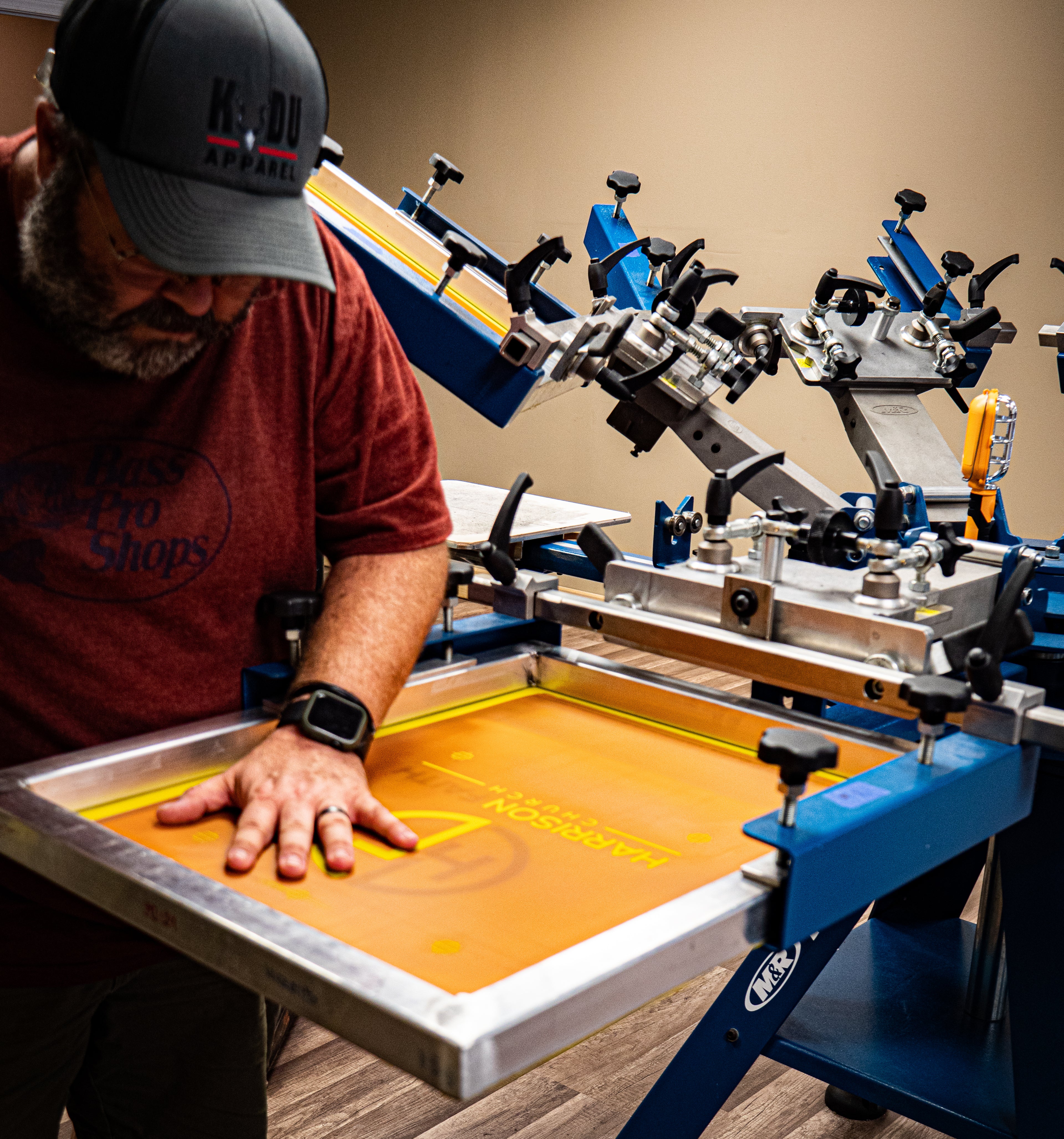Artistic Silk Screen Printing for Limited Edition Prints
Artistic Silk Screen Printing for Limited Edition Prints
Blog Article
Screen Printing Uncovered: Everything You Need to Know Concerning Tee and Garment Printing Strategies
Screen printing is an interesting method that incorporates art with technique, using unlimited possibilities for creative thinking. All set to explore the important components that make screen publishing an art kind?
The Fundamentals of Screen Printing: Just How It Functions
When you plunge into screen printing, you'll discover it's both an art and a scientific research. At its core, screen printing entails developing a stencil, or screen, that allows ink to pass with only in certain locations.
Next, you'll mix your inks and prepare your printing surface. Placement the display over the textile, after that use a squeegee to press ink via the display onto the garment. This procedure requires precision, as you want clear, vibrant prints. After printing, you'll treat the ink with heat, ensuring it complies with the material and lasts with laundries. Each action is essential, and mastering them will certainly elevate your display printing skills, transforming straightforward garments right into distinct, meaningful items.
Sorts Of Screen Printing Methods
Once you comprehend the fundamentals of screen printing, it's time to explore the different strategies that can boost your designs. One popular method is conventional display printing, where ink is pushed with a stenciled display.
If you're going for great details, think about discharge printing. This technique removes dye from the material, leaving a soft, vintage look. An additional choice is plastisol printing, recognized for its toughness and vivid colors, making it a preferred for numerous brand names. Experiment with halftone printing to create gradient impacts and intricate styles. Each technique has its special charm, so do not think twice to attempt them bent on discover what fits your design best!
Crucial Tools for Screen Printing
To attain sensational outcomes in display printing, having the appropriate equipment is essential. You'll need a sturdy display printing framework, which holds the mesh that transfers your style onto the garment. Next off, spend in premium mops; these are crucial for applying ink equally across the screen.
Picking the Right Inks and Products
When picking inks and products for screen printing, you need to think about the sort of ink that works ideal for your job. Assume about material compatibility to assure your styles look last and excellent lengthy. Discover green ink alternatives to make your printing procedure much more lasting.
Sorts Of Display Inks
Selecting the right display ink is necessary for attaining dynamic, long lasting prints that satisfy your task's demands. There are numerous sorts of display inks to analyze. Plastisol ink is prominent for its adaptability and simplicity of use, giving excellent color opacity on dark textiles. Water-based ink, on the other hand, provides a softer feel and is green, making it perfect for those wanting to reduce their ecological effect. Discharge inks remove dye from the material, leading to a soft, vintage look yet need specific handling. Specialty inks, such as glow-in-the-dark or metallic, can include special effects to your styles. Evaluate your job demands and pick the ink that aligns best with your wanted end result.

Fabric Compatibility Factors To Consider
Understanding fabric compatibility is crucial for accomplishing top notch screen prints, especially considering that different products react distinctly to various inks. Constantly check your inks on example textile to assure they adhere effectively and keep shade integrity. Furthermore, keep in mind that material weight and texture can influence the final end result, so selecting the right ink and product combination is crucial for your project's success.
Eco-Friendly Ink Options
Eco-friendly inks are becoming a prominent option for screen printers that wish to reduce their ecological impact while preserving quality. When picking inks, think about water-based inks, which are much less dangerous and easier to cleanse up contrasted to traditional solvents. These inks bond well with materials, delivering dynamic outcomes without hazardous chemicals. You might likewise check out eco-solvent inks that use fewer volatile organic compounds (VOCs), making them a safer choice for both your health and the planet.
Additionally, try to find inks made from renewable energies, such as soy or vegetable-based options. By picking the appropriate inks and products, you'll not only create magnificent styles however also add to a much more lasting printing procedure. Make the switch, and your prints will mirror your dedication to the setting!
Preparing Your Layout for Screen Printing

Submit Format Demands
To guarantee your layout looks sharp and lively on fabric, you'll require to pay attention to file layout requirements for screen printing. Beginning with vector files like AI or EPS, as they can be scaled without shedding top quality. If you use raster images, go with high-resolution documents, such as TIFF or PNG, preferably at 300 DPI. Avoid making use of JPEGs, as they can shed quality when resized. Also, see to it your design has a transparent background to avoid unwanted white edges on your prints. Finally, maintain color modes in mind; CMYK is standard for screen printing, so convert your RGB creates as necessary. By complying with these standards, you'll establish your artwork up for an effective print.
Color Separation Methods
Shade separation is an essential action in preparing your style for screen printing, and mastering it can substantially enhance your print top quality. You'll require to break your layout into private shades, as each color needs a different display during printing. Beginning by identifying all the shades in your style and produce layers for each one. You can use software program like Adobe Photoshop or Illustrator to separate and different shades properly. Be specific to save each layer as a different file, typically in a style like TIFF or PSD. This accuracy not just ensures precise color depiction but likewise improves the printing process. By taking note of shade separation, you'll accomplish specialist and vibrant results in your screen-printed garments.
Resolution and Dimension
Accomplishing the very best lead to display printing begins with guaranteeing your design has the ideal resolution and size. Ideally, your artwork ought to go to least 300 DPI (dots per inch) for my response sharp, clear prints. Your last item might look less than professional and pixelated. if you make use of lower resolution.
When it concerns dimension, take into consideration the measurements of your print location. Layout your art work to match my company the final print dimension, preferably developing it in the actual measurements you'll be printing. By doing this, you'll stay clear of any type of unforeseen scaling issues.
Constantly check your style in both vector and raster styles. Vector graphics can be scaled without shedding quality, making them suitable for screen printing. Preparing appropriately will assure your style looks amazing on every garment!
Step-by-Step Display Printing Refine
Display printing is a vibrant process that enables you to create lively styles on numerous surfaces. To obtain started, you'll require a screen, solution, and your selected ink.
After cleaning out the unexposed emulsion, your screen prepares. Establish it up on your printing surface area and align your garment under it. Pour ink onto the display and use a squeegee to push the ink with the stencil onto the fabric. Lift the display very carefully and let the print dry. Heal the ink utilizing warmth to ensure sturdiness. That's it! You've effectively display printed your design.
Tips for Successful Display Printing Projects
While you're diving right into your screen printing projects, bear in mind that prep work is vital to success. Start by collecting all your materials-- inks, garments, displays, and squeegees. A tidy workspace aids protect against unwanted errors, so clean before you start.
Following, verify your artwork is high-resolution and properly sized for your garment. Test your screen for correct exposure and tidy it extensively to avoid spots. When mixing your inks, follow the supplier's guidelines to achieve the appropriate uniformity.
Throughout printing, use even pressure with your squeegee for regular results. Don't hurry; take your time to confirm each print fulfills your requirements. After printing, allow your garments completely dry entirely prior to managing or packaging them.
Finally, always keep an example of your benefit future recommendation. This method, you can evaluate your progress and enhance your techniques in time. Pleased printing!

Frequently Asked Concerns
Exactly how Lengthy Does It Take to Establish up a Screen Printing Work?
Establishing a display printing job commonly takes about thirty minutes to an hour. You'll prepare the screens, mix inks, and readjust journalism. The time varies based upon intricacy and experience, so remain arranged!
Can I Print on Different Material Enters Making Use Of the Same Method?
Yes, you can print on various material types using the exact same method, however you'll require to readjust your inks and settings. Some textiles soak up ink in different ways, so trying out warranties the very best outcomes for each and every material.
What Prevail Errors to Avoid in Display Printing?
When screen printing, stay clear of common errors like using the wrong ink, neglecting correct exposure times, or missing pre-press checks. Constantly evaluate your arrangement and maintain clean screens to guarantee quality outcomes each time.
Exactly How Can I Effectively Tidy and Keep My Screen Printing Equipment?
To properly tidy and preserve your screen printing devices, you should routinely wash displays with proper solvents, examine mops for wear, and assure all tools are saved dust-free and completely dry. Consistency prevents costly repair services and enhances efficiency.
Is Display Printing Eco-friendly Contrasted to Other Techniques?
Screen printing can be a lot best site more eco-friendly than various other methods, particularly if you make use of eco-conscious products and water-based inks. By selecting sustainable products and practices, you reduce waste and reduce your influence on the planet.
Screen Printing Uncovered: Every Little Thing You Required to Know Regarding Tee Shirt and Garment Printing Methods
At its core, screen printing entails producing a stencil, or screen, that allows ink to pass through just in certain areas. Placement the display over the fabric, then make use of a squeegee to press ink with the screen onto the garment. One popular method is conventional screen printing, where ink is pushed through a stenciled screen.When picking inks and materials for screen printing, you need to take right into account the kind of ink that functions best for your task.
Report this page